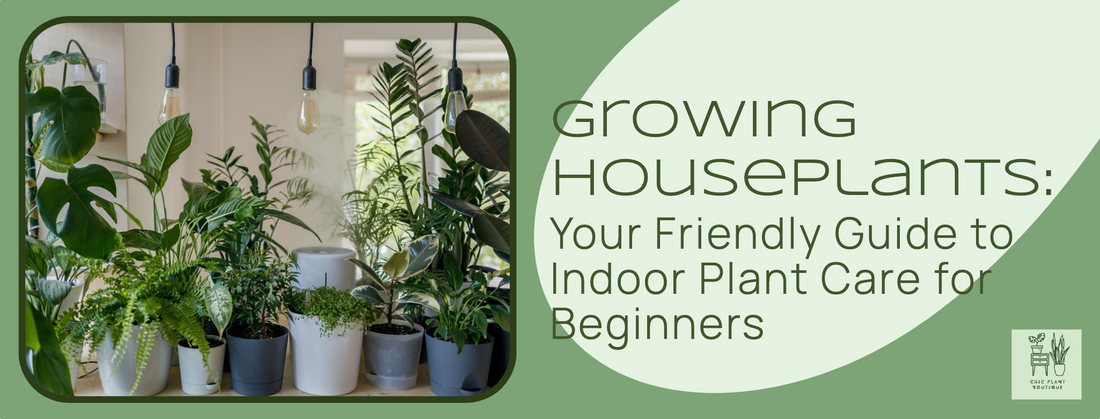
Growing Houseplants: Your Friendly Guide to Indoor Plant Care for Beginners
Share
Growing houseplants can be an incredibly rewarding journey, especially for beginners looking to breathe life into their indoor spaces. As you embark on this adventure, you'll find that nurturing plants not only enhances your home decor but also brings a sense of calm and accomplishment. In this friendly guide, we'll explore everything you need to know about growing plants indoors, from understanding the best lighting conditions to mastering the art of watering. Whether you're a pet owner mindful of safe plant choices or a budding enthusiast seeking a green thumb, you'll gain the confidence to tackle common challenges and create a thriving indoor garden. So, let's dig in and discover how to transform your home into a lush, inviting haven with the perfect houseplants.
Choosing the Right Plants

When you're just starting out, picking the right plants for your home is crucial. You want to ensure they’ll thrive in your specific environment. Snake plants, pothos, and peace lilies are fantastic beginner choices. These plants are pretty forgiving if you forget to water them now and then.
If you're a pet owner, you'll want to keep your furry friends safe. Opt for pet-friendly plants like spider plants, Boston ferns, or cast iron plants. I once met someone who swore her cat loved to lounge under the leaves of her spider plant—making it a win-win for both the plant and pet!
Mastering the Art of Watering
Watering is an area where a lot of new plant parents stumble. A helpful rule of thumb is to check the top inch of soil; if it's dry, your plant’s probably thirsty. Over time, you'll get a feel for how often each of your plants needs a drink. Don't worry if you slip up now and then—we’ve all been there, and plants are a resilient bunch!
Finding the Perfect Spot

Lighting is a fundamental aspect of successful plant care that can truly make or break your journey as a plant parent. Understanding light conditions in your home is a great start. Most houseplants thrive in indirect sunlight, which simulates the dappled light they might experience in their natural habitats. Hence, positioning them near north or east-facing windows is usually a safe bet, as these locations provide gentle and consistent light without the intense heat of direct sun.
Consider the specifics of your home environment when deciding where to place each plant. For instance, Michele, a fellow plant enthusiast, shared with me her experience of transforming her fiddle leaf fig. She noticed it was languishing in direct afternoon sun and decided to move it just a couple of feet into a spot with filtered light. Surprisingly, this simple adjustment turned her plant from a sulking housemate into a vibrant, leafy friend. Don't hesitate to experiment; sometimes, a small tweak can lead to big transformations.
Dealing with Common Challenges
As you tend to your plants, you might encounter a few common challenges, such as brown leaf tips or yellowing leaves. Don’t sweat it—these issues are part of the learning curve and can often be corrected with a bit of detective work. Brown tips might suggest that your plant is getting exposed to too much direct sunlight or could be craving more humidity—an easy fix with a humidifier or by grouping plants together. On the other hand, yellow leaves could be a symptom of overwatering, indicating it's time to adjust your watering schedule.
It's important to remember that each plant sends out signals to communicate its needs. By paying close attention to these cues, such as drooping, wilting, or discolored foliage, you'll eventually become adept at deciphering your plants' unique requirements. Over time, this skill comes naturally, turning you into a plant care pro with a flourishing indoor garden to show for it.
Creating Your Cozy Green Space
With the basics under your belt, it's time to let your creativity shine as you start arranging your plants in innovative and artistic ways. The beauty of indoor gardening lies in the versatility of plant displays. By grouping different varieties together, you not only create eye-catching arrangements but also help enhance the overall humidity in your home—a much-appreciated bonus for your leafy companions seeking tropical-like conditions.
Your personal space is a reflection of who you are, so embrace your interests and style preferences with enthusiasm. Consider mixing taller, statement plants with smaller, understory plants to create visual interest and depth. Whether you're placing a bold monstera as an anchor piece in your living room or a petite succulent ensemble on your office desk, each plant adds a unique splash of personality and vibrancy to your environment. By curating a cozy green space that speaks to you, you cultivate a haven that feels truly inviting and inherently yours.

Happy Growing!
If you ever feel stuck or just want to share your plant journey, hop into our facebook group or reach out on my instagram page. There’s a whole world of plant lovers out there ready to support and cheer you on. So go ahead, embrace the plant parent life—it’s a thriving adventure worth every green moment.